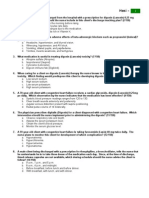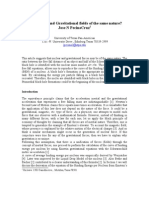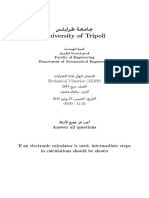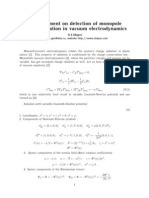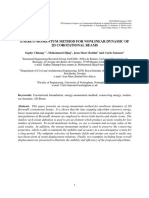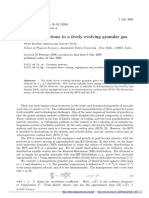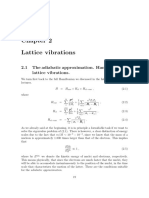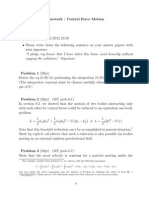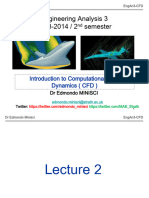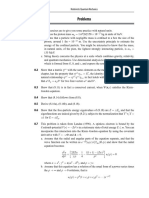The Royal Society
The Royal Society
Uploaded by
Abey VettoorCopyright:
Available Formats
The Royal Society
The Royal Society
Uploaded by
Abey VettoorOriginal Title
Copyright
Available Formats
Share this document
Did you find this document useful?
Is this content inappropriate?
Copyright:
Available Formats
The Royal Society
The Royal Society
Uploaded by
Abey VettoorCopyright:
Available Formats
The Inverse Square Law of Gravitation.
III
Author(s): E. A. Milne
Source: Proceedings of the Royal Society of London. Series A, Mathematical and Physical
Sciences, Vol. 160, No. 900 (May 1, 1937), pp. 24-36
Published by: The Royal Society
Stable URL: http://www.jstor.org/stable/96852 .
Accessed: 07/05/2014 16:49
Your use of the JSTOR archive indicates your acceptance of the Terms & Conditions of Use, available at .
http://www.jstor.org/page/info/about/policies/terms.jsp
.
JSTOR is a not-for-profit service that helps scholars, researchers, and students discover, use, and build upon a wide range of
content in a trusted digital archive. We use information technology and tools to increase productivity and facilitate new forms
of scholarship. For more information about JSTOR, please contact support@jstor.org.
The Royal Society is collaborating with JSTOR to digitize, preserve and extend access to Proceedings of the
Royal Society of London. Series A, Mathematical and Physical Sciences.
http://www.jstor.org
This content downloaded from 169.229.32.136 on Wed, 7 May 2014 16:49:53 PM
All use subject to JSTOR Terms and Conditions
The Inverse Square Law of Gravitation-III
BY E. A. MILNE, F.R.S.
(Received14 January 1937)
1-In a preceding paper a relativistic formulation of the law of gravita-
tion was obtained, in the flat private space of any fundamental observer in
the substratum or smoothed-out universe, in terms of t-measures. In other
papers,* general formulae have been given for the transformation of forces,
equations of motion, etc., from t-measures to r-measures. They may be at
once applied to express the law of gravitation in r-measures, in the public
hyperbolic space de2 in which the extra-galactic nebular nuclei appear at
rest. The present paper carries out this programme, and so obtains the law
of gravitation in the form appropriate to the r-dynamics, which corresponds
to classical mechanics.
2-Let 0 be any fundamental particle of the substratum, P the position
vector of any other particle P with respect to 0, at epoch t, in t-measure.
The t-clocks of the fundamental observers have been graduated so that the
fundamental particles appear in uniform (Whitrow 1935) relative motion.
These clocks are then regraduated from t to r, where
-r=to log(t/to) +to, (1)
to being the present value of t. All measures must then be transformed
accordingly. Let P -i, where i is a unit vector in the direction of polar
co-ordinates 0, qS. Then it has been shown that the event (1,0, 04,t) in
t-measures is described in r-measures as (A,0, 0, r), where
r-to A
t = toe to cosh - (2)
7-to A
l/c= toe to sinh -. (3)
* The relevant references are: " World-structure " Milne (I935); " On the founda-
tions of dynamics" (Milne 1936 a); "The inverse square law of gravitation" (Milne
1936b); "Kinematics, dynamics and the scale of time" (Milne 1936c, 1937 a, b);
"The inverse square law of gravitation-II", see p. 1.
[ 24 ]
This content downloaded from 169.229.32.136 on Wed, 7 May 2014 16:49:53 PM
All use subject to JSTOR Terms and Conditions
The Inverse Square Law of Gravitation 25
3-Now consider two massive particles P1, P2, of masses ml, Mn2. It
has been shown that associated with events (P1, tl) (P2, t2) at P1 and P2
there is a gravitational potential energy Xgiven by
_ mln2C2 X12
%=- _Mo (X2-4)
where X1 = t_-P2/c2, X2 t_-P2/C2, X12 t1t2-P1*P2/C2, (5)
and Mois the mass of the fictitious universe. In the experience of 0, at O's
world-wide instant t, (4) is to be interpreted by putting t1 = ta = t. The
value of the constant of gravitation is
y =
c3t/MO2. (6)
To transform (4) (which, being an energy, is a time-invariant) we put
P1=11il, P2=12i2, (7)
and apply (2) and (3). We find in r-measure
A' 2
mine2 1cosh A2- sih
cosh A1l sinh A2(il. 2)
x M1 Alcosh nh
sinhLsA (8
Mo[(cosh s22sinhA h t2(l.2) -1
This may be written in the alternative form
v_-
_ 2
MO
A1 A2 A1 .A
cosh -l cosh `2- sinh - sinh-t2 (i1. i2)
X A1 A2 2(8'
L( cosh -sinh i2 _cosh A2 sinh AAl
-i) -sinh2A sinh2 2
(il A i2 )2j
Ct
to ct co cto cto
Formula (8) or (8') gives the potential energy of two particles of masses inl,
M2,at positions (A1,i1), (A2,i2) respectively.
4-It will be noticed that in (8) and (8') mention of the epochs r1and r2
has completely disappeared;X is now a function of the spatial co-ordinates
of P1 and P2 only. This is a particular case of a general theorem given
previously (Milne 1937 b, ? 15), according to which any potential function
X(P, t) when transformed to r-measures becomes explicitly independent
of t. It follows that in T-measureit is not necessary to specify the epoch
to which Xrefers.
This content downloaded from 169.229.32.136 on Wed, 7 May 2014 16:49:53 PM
All use subject to JSTOR Terms and Conditions
26 E. A. Milne
5-To see the significanceof (8) and (8') choose the origin 0 to be on the
line joining P1P2,in the sense 0P1P2. Then A2>A1, and i1 = , so that
il. 2=1. Formula (8) now becomes
m1m2C21
% O ctanhAl (9)
cto
This may be written
%= ,
y0m1m2
ctotanhA2Al (9')
cto
where yo is the present value of y, given by
Yo = C3to/1IVO. (6')
The numerical value of yo, deduced from the recession of the galaxies and
the mean density of matter in space near ourselves, has been shown to be
about equal to the empiricalvalue of the Newtonian constant of gravitation
(Milne 1936a, Appendix 1).
Formula (9') gives the mutual potential energy of m1at P1and m2at P2
in the public static hyperbolic space
de2 = dA2+ (ctO)2sinh2 A (dO2+ sin26 dqs2).
cto
Since for collinear particles co-ordinate distances A have been shown
(Milne 1937a, ? 22) to be additive, (A2-A1) is independent of the origin 0
in the line P1P2, and y depends only on the r-measure of the distance
between the particles.
For (A2-A1) < ctO, (9') reduces to
y0m1m2 '(0
(10)
A2-Al
This agrees with the empirical Newtonian expression for the potential
energy. We have seen in the preceding paper that in t-measure the Newtonian
formula is exact; we now see that in T-measure the exact formula for x
involves mention of cto, the present radius of the universe in t-measure.
In ordinary experience it is immaterial whether we use T-measure or
t-measure.
6-The private Euclidean spaces of the t-observers extend only to distance
ct, but the public hyperbolic space d62 extends to infinity. Formula (9)
shows that as (A2-A1) -oo,
m1m2c2 (11)
This content downloaded from 169.229.32.136 on Wed, 7 May 2014 16:49:53 PM
All use subject to JSTOR Terms and Conditions
The Inverse Square Law of Gravitation 27
We have already had a similar result in t-measures. This result must be
contrasted with the limit of the empirical formula (10), which is zero. The
change is connected with the circumstance that it is impossible to remove
a particle "to a large distance from all attracting matter", for a particle
is always in the presence of the substratum.
7-The "attraction" exerted by P2 on P1 has been defined as - grad x.
In r-measure,when 0 is chosen collinear with P1and P2, the A-component
of this attraction is
ax YO ml 2 (12)
aAl (cto)2sinh2At
Cto
This is directed towards P2. For (A2- Al)) ctO, it gives
aX _0Y1MlM2 (3
aA1 (A2-A1)2 (13)
This is the inverse square law of attraction, of which (12) appears to be the
exact form in r-measure. The attraction tends to zero as (A2-A1) -oo.
Further, when 0 is collinear with P1 and P2,
ax+1 -a i0, (14)
(aA1j ( aA2
?
so that action and reaction are here equal and opposite.
8-In the previous paper it was shown that Xin t-measure satisfies the
differential equations
1V a2x= ___a2
= 0.
V2%-- 0, V2XX1t2 (15)
The r-measureof x must therefore satisfy the r-transformationsof (15).
Now if to the wave equation
V2 -28a2x0()
IV2X =? (16)
Xc2 at2
we apply the transformation of co-ordinates (2), (3), we find that a factor
z-2to
e to divides through, and we are left with
1
aLh~2 AaX 1ina A (snax)? a2x
sinh2-a ct0aA (Cto)2sih
A
s____ oao ao sin260a02j
cto ct'
I a2
Ct aX 0. (17)
-c2ar2 Ct0aT
This content downloaded from 169.229.32.136 on Wed, 7 May 2014 16:49:53 PM
All use subject to JSTOR Terms and Conditions
28 E. A. Milne
Since Xin r-measure is explicitly independent of r1 and '2, it follows that
Xas given by (8) satisfies the equations
a 2)la 1. ax I _2
1Co2
A1L(cto)2sinh2 + sin 01 ( sin2 01D (18)
1~ 1 -0 (8'
[Cto)2sinh2
( 2_ sin02x) ' (
aA (tsncA2eaA%]+sin 02 a2 2aao2 sin20
where we have put
i (cos 01, sin 01 cos 51, sin 0 sin 01),
i2= (COS 02, sin 02 COSq02,sin 02 sin02).
Equations (18), (18') are just Laplace's equation in the space de2. It will
be seen that the dual description of gravitation by means of t-measures and
T-measures removes the old difficulties associated with the propagation of
gravitation. A gravitational potential will appear to be propagated as
waves moving with the velocity of light in t-measure, but the same potential
will appear as propagated instantaneously in r-measure.
As a verification, take the case when 0 is at P1. Then A1 0, and X
reduces to
%_
-y70 mlm2 (19)
cto tanh -
ct0
Since it is now explicitly independent of 02 and 02' (18') reduces to
a[(~~t0)2 A2~
A2[(cto)2sinhC ct0 t ] =?
which is obviously identically satisfied. For Al,A2<ct0, (18) and (18')
reduce to Laplace's equation in flat space in spherical polars.
A complete theory of the potential in the hyperbolic space de2 could now
be constructed from the elementary solution (19). We shall not undertake
this here.
9-In accordance with the general theory given previously, the force on
P1 exceeds the attraction on P1 by a term involving the rate of change of
mass of P1. We have (Milne i937b, ? 15, equation (45))
OA --+2 '1, (20)
=-al
A1 aA1
( 1- 2,/mlc2)dr (1-2-/nlc2)(
where 1 2 + (cto)2sinh2 c (102+ sin26q2l)]
gl- = l (21)
This content downloaded from 169.229.32.136 on Wed, 7 May 2014 16:49:53 PM
All use subject to JSTOR Terms and Conditions
The Inverse Square Law of Gravitation 29
dots denoting differentiationswith respect to r. We have similar formulae
for q00and 00-
When P1 is in the vicinity of 0, (Al'cto), we can put 11 _ Ali1, and
write the force in the local vector form
qi1 2+ 2v, d Ml 1 (22)
aII1l (I - V2l/ 2)dr[(1-v2/C2)1]'(2
where v1 = d1l/dr, X = -yOm1m2/ 1II2-II1 jI
10-Again, by the general theory (Milne I937b, ? 15, equation (46)), the
equations of motion of P1under the "action" of P2 and the substratum are
(1-2Jj/mlC2)A [dr( .,) A ay (23)
and two similar equations in 01 and 01. There is a similar set of three
equations of motion for P2. Combiningthe six with multipliersA1, 01, etc.,
we readily find the energy integral
m1- c 2 ?c2 = const. (24)
(1-2~/ic2~+(1- 2-M
Equations (23), etc., are the general equations of motion for the two-body
problem, in r-measures,for its description by any observer at "local rest",
i.e. by any observer sharing the mean motion of the nearby nebular nuclei.
11-In our ordinary experience the two particles P1 and P2 will be at
distances from a fundamental particle not comparable with cto (which is
2 x 109 light-years). If we take A1,A2<<Cto, the space becomes locally
Eucidean and the equations of type (23) may be put in the vector forms
(1 -Yi1 M,dvl =-a =_1_ (25)
2j d= 1I -YOMIM~2 131I2~
-22) m2dv2 =X 2- 1,1 (25')
di"= 12 YO1m 1~1.
In these equations the velocities vl, V2are not restrictedto be small compared
with c, but they must be measured in the frame at local cosmical rest.
Equations (25), (25') possess the energy integral
in12 m2C 2 Yoini 2
(1 V/C2Y2
+ (1 -V /C2)= I I -
const. (26)
We can eliminate the interaction terms in (25) and (25') by multiplying them
vectorially by JiI and 112,respectively, and adding, as in the usual procedure
This content downloaded from 169.229.32.136 on Wed, 7 May 2014 16:49:53 PM
All use subject to JSTOR Terms and Conditions
30 E. A. Milne
for obtaining the angular momentum integral, but the resulting equation
does not appear to be integrable. We find in fact
m1fl1 Advl/d-r m2fl2Adv2/dr = 0 (27)
(l1v2/C2)4 (12/C2)i -
When the velocities are small comparedwith c, (27) integrates in the form
I1 A M v1+I2 Am2 V= const.,
which is the usual angular momentum integral. The motion is then in a
plane, and is the ordinaryKeplerian motion.
12-We cannot however use (25) and (25') to calculate the relativeorbit
of either particle as observedfrom the other,in general, for we do not know
the transformations from a fundamental particle-observerto an observer
in motion relative to him, in the r-dynamics. To a first approximationsuch
transformations will be the transformations of Newtonian relativity, but
the exact transformations may be expected to differ from these by terms
in I/c2, for the finding of which no method has yet been given. Thus (25)
and (25'), though they should yield the motion of a planet round the sun
as observedfrom thecentreof thegalaxy (or in the mean velocity frame of the
galaxies in our own neighbourhood), are not competent to yield the,
relativistic refinementsof the relative motion of sun and planet as observed
from either sun or planet, for the sun is not at local cosmical rest-it is,
roughly speaking, rotating round the galactic centre besides having a
peculiar motion of its own. The sun's velocity relative to the standard of
local rest may be expected to be an essential datum in the calculation of
these refinements,for example in the calculation of the motion of perihelion
of a planet. Equations (25) and (25'), in r-measures, are invariant in form
for transformationsfrom any frame at local nebular rest to any other such
frame, but they must not be expected to be invariant for transformations
to other frames, even to frames in uniform relative motion with respect to
"local rest". The reason is that whilst all fundamental particles are "equi-
valent" in the technical sense, a fundamental particle is not equivalent
to a non-fundamental particle such as the sun. In the frame associated
with a non-fundamental particle, i.e., in terms of observations carried out
by an observer not at local nebular rest, the relation to the distribution of
matter-in-motion in the universe will be different, and accordingly the
derived laws of dynamics, which (in agreement with Mach's conjectures)
we have shown to be intimately connected with the distribution of matter-
in-motion in the universe, will be slightly different. Thus, although (25) and
(25') embody a rigorous formulation of the general two-body problem in
This content downloaded from 169.229.32.136 on Wed, 7 May 2014 16:49:53 PM
All use subject to JSTOR Terms and Conditions
The Inverse Square Law of Gravitation 31
T-measures,as it would appear to an observer on a nebular nucleus or other
particle at local rest, they require transformation in a manner not yet
discovered before they can be used to yield the orbit to any other type of
observer,for example an observer on either particle. It is much to be hoped
that some method will be evolved for determining such transformations.*
In the meantime we may be content with having determined the equations
of the two-body problem in frames at local rest, and with pointing out the
possibility of deviations from the motions predicted by Newtonian or
"general" relativity consequent on one of the bodies concerned not being
at local rest. It is possible that such effects as the unexplained terms in the
moon's motion which are outside current gravitational theory, may be due
to the earth's or sun's motion in the frame defined by the local standard
of rest.
13-Since (25) and (25') do not appear to admit an exact integral of
angular momentum, the relative orbit does not appear to lie accurately in
a plane. In certain special cases we can however obtain an integral of
angular momentum. These will now be considered.
14-Let one of the particles be itself a fundamental particle, namely a
nebular nucleus of large mass M. Then the reaction on it of the second
particle may be neglected. Put m2 M, ml = m, and take Il2 = 0, II, = II.
Then II2, by (25'), will be permanentlyzero if m < M, and we have the single
equation dv [
(1 -v2/c2) - = Yo M fl 131 (28)
The energy integral is now
(1-V2/C2)1 I I= const., (29)
and by multiplying (28) vectorially by II we obtain
dv
lAd =0,
which integrates to yield the integral of angular momentum
IIAv =const. = h (30)
This is Kepler's Law of Areas in the r-dynamics. The orbit of m, judged
from 0, now lies in a plane perpendicularto ho. That (30) is consistent with
* Since the above was written, the requiredtransformationshave been found.
This content downloaded from 169.229.32.136 on Wed, 7 May 2014 16:49:53 PM
All use subject to JSTOR Terms and Conditions
32 E. A. Milne
the corresponding integral of angular momentum in t-measure as previously
(previous paper, formula (56)) obtained, namely
PAV = AZ, (31)
may be seen as follows. Writing Z = Xi Yi 6i, transforming to r-measure by
using
T-to T-to
6i=dr/do, Yidt = ds = e to do, Xi = tOe to
the integral (31) becomes
r-to A -T-todT dF -it0 A1 dT t,
ct0e to sinh-iAe to-- ct0e to sinh-I i- A-toe to
cto do-dT cto j do
or, for A<ct, II= Ai, II AdE = A t (32)
which is (30). We see once again how the secular increase of angular
momentum in t-measure given by (31) reduces to a constant angular
momentum in T-measure.
The integrals (29) and (30) may now be expressed in plane polar co-
ordinates and yield a Keplerian orbit in -measure modified by terms in
1/c2. The description of this orbit in t-measure has been considered in detail
in Part II (?? 17-27) of the papers under the present title, and shown to ex-
plain the general spiral character of motion round a nebular nucleus.
15-Again, let one of the two particles be a non-fundamental particle
(e.g. the sun) of mass M large compared with the other particle m. Then,
by (25'), v2, the velocity of M, is approximately constant. Hence we can
write (25) in the form
-V1 0 [I1-II2] =Yom X
dT2 1o l- I2 (33)
This admits the integral of angular momentum
dT
(fl1-II2)ATr(fIl-fl2) = const. = ho(34)
say, and the relative vector (fl- HO2),as viewed by a neighbouring funda-
mental particle 0, lies in a fixed plane perpendicular to ho. The energy
integral reduces to
C2 Yom
(1 - Vl/C2)i- nY?- n | = const. (35)
Equation (33) or the integral (35) shows that even the relative orbit, as
viewed by 0, depends to terms in 1/C2on the absolute velocity v1 of the small
This content downloaded from 169.229.32.136 on Wed, 7 May 2014 16:49:53 PM
All use subject to JSTOR Terms and Conditions
The Inverse Square Law of Gravitation 33
particle m in the frame at local rest. This is of course an effect of the sub-
stratum, since v1 is the velocity relative to the substratum in -r-measure.
The further solution of (33) lies more in the province of an astronomical
paper.
RECAPITULATION
16-The theory of dynamics and gravitation which has been developed
in the present series of papers should be competent to deal with the general
problems of the motions in galaxies, the proper motions of galaxies, the
effects (tidal or otherwise) of galaxies on one another and any problem
involving the relations of moving matter to the general distribution of
matter in the whole universe. The theory is a purely logical one, reposing
on the existence of a temporal sequence in the experience of each individual
observer (Milne I935, chap. 2). The theorems which have been deduced,
which appear as laws of dynamics and gravitation, are purely logical con-
sequences of the definition of a substratum as a set of " equivalent particles",
equivalent both in the kinematical (A B) and statistical (A -B) senses.
An early theorem (Milne I935, ?? 96-103) showed that, without any appeal
to empirical or assumed laws of dynamics or gravitation, such a system will
continue of itself, without the imposition of external constraints, in the
prescribed motion. The system was thus shown to be a natural one, and it
was shown by Whitrow that any system of equivalent particles, whatever
their relative accelerations as judged by time-signalling conducted with the
clocks belonging to them, could be reduced to a substratum in uniform
relative motion by appropriate regraduation of these clocks. The author
had in fact previously obtained the general transformations for the ac-
celerated motion of equivalent particles, of which particular cases are the
classical Lorentz formulae (Milne 1935, chap. 2, equations (33)).
A fundamental step was then the determination of the free motion of an
additional test-particle in the presence of a substratum. This was embodied
in two theorems, first the determination of the form of the acceleration
formula in a form involving a certain function G(6), secondly* the deter-
mination of G(6) for a substratum as G(6) - 1, independent of the particle-
density in the substratum. This permitted the fixation of the measure of
external force F acting on a constrained particle in terms of the departure
of the actual motion from the calculated free motion, and in turn the
construction of a complete dynamics of such constrained motions. Rate of
performance of work was defined as the complete scalar product of a force
* A purely kinematical proof of this result is given by Milne (I937 C).
Vol. CLX-A. D
This content downloaded from 169.229.32.136 on Wed, 7 May 2014 16:49:53 PM
All use subject to JSTOR Terms and Conditions
34 E. A. Milne
into the velocity of the particle relative to its immediate environment in
the substratum. This led to the identification of Mc26t, a function of the
position, velocity and epoch of the particle considered, as energy.* The
dynamical properties of the substratum could be described as those of a
conservative "gravitational " field in which the constant of gravitation was
taken to be c3t/Mo.
At this stage the resulting dynamics, though formally resemblingclassical
dynamics in certain relations, such as Einstein's relation E = MC2,appeared
as essentially differentfrom it. The measuresof the fundamental dynamical
magnitudes involved specification of the position and epoch of a particle,
relative to an observer 0, as well as of its velocity, but more surprisingly
there appearedin equations of motion a term representingthe gravitational
pull of the substratum. It was then shown that the dynamical magnitudes
reduced to their classical expressions, and that the cosmical acceleration-
term in the equations of motion completely disappeared,if the clocks of all
fundamental particles, previously graduated to read the time t in which
the substratum or universe was expanding uniformly, were regraduated
to read time r, where 7
= t log(tlto) +to,
to being the present value of t. This regraduation of clocks carried with it
an adjustment of all derived magnitudes to the new time-scale T. Certain
magnitudes, called "time-invariants", proved to be unaltered by the re-
graduation-energy was an example-but others had different measures.
For example, y reduced to a constant c3to/Mo, and angular momentum,
shown to increase proportionally to t in t-measure, reduced (for a semi-
isolated system) to a constant in -r-measure;"velocity relative to environ-
ment" in t-measure reduced simply to "velocity" in r-measure. In all
cases the T-measuresplayed precisely the same parts in the transformed
equations as their classical counterparts play in classical equations. The
conclusion was inferred that in classical mechanics the independent time-
variablet is r, not t. Moreover r, the epoch-coordinate of any event
(whether at the observer or not), proved to be an invariant, the same for
all fundamental observers and consequently enjoying all the properties of
a world-wide Newtonian time. The resulting local equations of motion
differ slightly from Einstein's "special relativity" mechanics but possess
the same energy integral.
* The formula for energy was shown by Whitrow (1936) to be applicable to
photons.
t It had long been realized that "general" relativity, in treating all co-ordinates
as on the same footing, is not in a position to identify the independent variable
representing the time, as was explicitly recognized by De Sitter.
This content downloaded from 169.229.32.136 on Wed, 7 May 2014 16:49:53 PM
All use subject to JSTOR Terms and Conditions
The Inverse Square Law of Gravitation 35
It thus appears that the time t is appropriate in some contexts, the time r
in others. Dynamics has a dual structure. In T-measures, appropriate where
we use ordinary dynamics and gravitation, the fundamental particles appear
as relatively stationary, the universe appears as a non-expanding system,
and the natural origin of time t = 0 is relegated to T = - X0. This removes
certain difficulties concerning the time-scale of astronomy. The secular in-
crease of angular momentum in t-measure explains the general prevalence
of angular momentum in isolated " pockets " in the universe generally. It is
convenient in T-measures to use a public static hyperbolic space in which
to describe motion and position, whereas in t-measures it is convenient to
use observers' private flat spaces. In the hyperbolic space the motion of a
free particle obeys the Galileo-Newton principle of inertia, which replaces the
accelerations due to the substratum appearing in the t-dynamics. It follows
that inertia is simply the pull of the rest of the universe.
The red-shifts observed in the spectra of extra-galactic nebulae indicate
that atoms keep the time t, not T. The universe appears as finite, of radius ct,
in t-measures, but infinitely extending in r-measures. Thus the old questions
of whether the universe is or is not expanding, whether it is finite or infinite
in extent, are differently answered according to the scale of time and
dynamics adopted. The results obtained in these papers are intimately
connected with the refusal to adopt the notion of a rigid body as an inde-
finable concept; instead, length-measures are defined in terms of light-time,
whose numerical value depends on the scale of clock-graduation adopted. A
rod rigid on the T-scale is deemed to be uniformly expanding on the t-scale.
Concurrently with the general dynamics, an account of gravitation has
been developed, without any empirical appeal to quantitative laws of nature
or adoption of assumed " field equations ". It was first shown how to define
a conservative field of potential in t-measures. Then, by generalizing the
notion of a substratum so as to make it contain condensations and by
reducing these condensations to isolated massive particles, we determined
the potential energy to be associated with a pair of massive particles in
such a way that the actual motion of each, determined from kinematical
considerations, corresponded to the " field " of the other. This was expressed
in t-measure, in flat space, in Lorentz-invariant form. This determined the
law of gravitation by kinematic methods, and led to its exact formulation
in inverse square form. It was applied to the motion of a particle under the
influence of the substratum and a neighbouring galactic nucleus. The
combination of the secular increase in angular momentum with the secular
increase in y led to general spiral motions reducing to Keplerian motions
in -r-measures.
D 2
This content downloaded from 169.229.32.136 on Wed, 7 May 2014 16:49:53 PM
All use subject to JSTOR Terms and Conditions
36 E. A. Milne
This was of course a particular case of the general result that kinematic
arguments lead to a dynamics and gravitation (expressed in t-measures)
which reduce to classical mechanics and gravitation in r-measures.
Descriptions in t-measures seem the more fundamental, as they explicitly
involve the dependence of the phenomena on epoch t; in descriptions in
-r-measures,the present epoch to appears as a constant in exact formulae,
though disappearing in our ordinary approximations, but r-descriptions
are essentially ephemeral. Every phenomenon may equally be described
with the same logical correctnessin either mode of time-reckoning,but it is
important to know which mode is being employed in any given case.
SUMMARY
17-The law of gravitation for any two particles of masses m1 and M2,
as derived in a preceding paper, is expressed in T-measure,i.e. in a form
appropriate to the public hyperbolic space de2 in which the system of
nebular nuclei appears as at relative rest. For two particles separated by
co-ordinate distance A, the potential energy Xis given by
m1m2c2 1 yOm1m2
X -- -
MOttlinh A
ct0tanhA
~~~ct0 cto
whereyois a constant c3to/Moequal to the Newtonian constant of gravitation.
This reduces to the Newtonian expression for AKcto. Xsatisfies Laplace's
equation in hyperbolicspace, and yields the inverse squarelaw of attraction
with the appropriate modification for hyperbolic space. The relativistic
form of the equations of motion for the two-body problem is obtained, and
certaincases are discussed.The presentaccount of dynamicsand gravitation,
constructed by purely kinematic methods, is recapitulated.
REFERENCES
Milne, E. A. 1935 "Relativity, Gravitation and World-Structure." Oxford.
- 1936 a Proc. Roy. Soc. A, 154, 22.
- 1936b Proc. Roy. Soc. A, 156, 62.
- 1936c Proc. Roy. Soc. A, 158, 324.
- I937a Proc. Roy. Soc. A, 159, 171.
- 1937b Proc. Roy. Soc. A, 159, 526.
- 1937 c Quart. J. Math. 8, 22.
Whitrow I935 Quart. J. Math. 6, 257.
- 1936 Quart. J. Math. 7, 271.
This content downloaded from 169.229.32.136 on Wed, 7 May 2014 16:49:53 PM
All use subject to JSTOR Terms and Conditions
You might also like
- BS en 12258-1-2012Document186 pagesBS en 12258-1-2012Abey Vettoor100% (2)
- Niveau de Mixage CinemaDocument39 pagesNiveau de Mixage CinemaOdette PerreraNo ratings yet
- BS en 12255-16-2005-09Document15 pagesBS en 12255-16-2005-09Abey Vettoor100% (1)
- European Standard Norme Européenne Europäische NormDocument16 pagesEuropean Standard Norme Européenne Europäische NormAbey VettoorNo ratings yet
- BS en 12255-11 2001-Wastewater Treatment PlantsDocument15 pagesBS en 12255-11 2001-Wastewater Treatment PlantsAbey VettoorNo ratings yet
- 4a Bulk Water Meter Installation in Chamber Drawing - PEWSTDAMI004Document1 page4a Bulk Water Meter Installation in Chamber Drawing - PEWSTDAMI004Abey Vettoor100% (2)
- 3a Domestic Water Meter Installation in Meter Room Drawing - PEWSTDAMI003Document1 page3a Domestic Water Meter Installation in Meter Room Drawing - PEWSTDAMI003Abey Vettoor100% (1)
- PharmacologyDocument13 pagesPharmacologyCARTAGENA1100% (20)
- 1301 5428Document6 pages1301 5428Eliacim VelezNo ratings yet
- SHM QuizDocument4 pagesSHM QuizAndey HemanthNo ratings yet
- Are Nuclear and Gavitational Forces of Same NatureDocument12 pagesAre Nuclear and Gavitational Forces of Same NatureCris Villarreal NavarroNo ratings yet
- Thermal State of The General Time-Dependent Harmonic OscillatorDocument14 pagesThermal State of The General Time-Dependent Harmonic OscillatorSajjad ZafarNo ratings yet
- Are Nuclear and Gavitational Forces of Same NatureDocument12 pagesAre Nuclear and Gavitational Forces of Same Naturejpecina2No ratings yet
- 10 11648 J Ajop 20150302 12Document5 pages10 11648 J Ajop 20150302 12Gemmy94No ratings yet
- Energetics in Mazur Mottola Gravistar and Truncated WormholesDocument8 pagesEnergetics in Mazur Mottola Gravistar and Truncated WormholesaritzNo ratings yet
- Two Dof State Space RevDDocument15 pagesTwo Dof State Space RevDDeosharan RoyNo ratings yet
- AE409 Exam Spring2015Document5 pagesAE409 Exam Spring2015Ali AliNo ratings yet
- Thermo-Mechanical Simulation of Guided Waves in Pipes Excited by Laser PulsesDocument15 pagesThermo-Mechanical Simulation of Guided Waves in Pipes Excited by Laser PulsesAbdelali YacoubiNo ratings yet
- k a ka (θ - θ) ka (θ - θ)Document7 pagesk a ka (θ - θ) ka (θ - θ)Engr Saad Bin SarfrazNo ratings yet
- 8eb81b3e-6977-4a93-b3ee-e9c3d84c3320Document9 pages8eb81b3e-6977-4a93-b3ee-e9c3d84c3320hamedgoeixjNo ratings yet
- The Vector Potential of A Point Magnetic DipoleDocument18 pagesThe Vector Potential of A Point Magnetic DipoleAgtc TandayNo ratings yet
- Laplace TransformDocument12 pagesLaplace Transformedgar100% (1)
- 117Document11 pages117Mohammad Imran ShafiNo ratings yet
- EmonopolDocument3 pagesEmonopolFlavio FontanaNo ratings yet
- 6 CCM231 Exam 2010Document8 pages6 CCM231 Exam 2010douglas.gibbNo ratings yet
- Tarea01 PDFDocument4 pagesTarea01 PDFd1a4ppNo ratings yet
- TOV Equation With LambdaDocument16 pagesTOV Equation With LambdaNestor Rodrigo Ahumada AhumadaNo ratings yet
- SPA5304 Physical Dynamics Homework 10: (20 Marks)Document2 pagesSPA5304 Physical Dynamics Homework 10: (20 Marks)Roy VeseyNo ratings yet
- Maxwell Distribution of Molecular VelocityDocument3 pagesMaxwell Distribution of Molecular VelocityAlexa scouta0% (1)
- Bernal 2014 First Mode DampingDocument32 pagesBernal 2014 First Mode DampingSergio David Valle PeñalverNo ratings yet
- Energy-Momentum Method For Nonlinear Dynamic of 2D Corotational BeamsDocument11 pagesEnergy-Momentum Method For Nonlinear Dynamic of 2D Corotational BeamsThomás VerderesiNo ratings yet
- Practice Mock Test-2024 - T02 (Code-A) - QuestionDocument15 pagesPractice Mock Test-2024 - T02 (Code-A) - Questionudhav malpaniNo ratings yet
- Input-Output Relations in OpticalDocument46 pagesInput-Output Relations in OpticalLucas RibeiroNo ratings yet
- The Mufflers Modeling by Transfer MatrixDocument8 pagesThe Mufflers Modeling by Transfer MatrixCarlos SolerNo ratings yet
- The K Ahler Geometry of Toric Manifolds: E-Mail Address: Apostolov - Vestislav@uqam - CaDocument61 pagesThe K Ahler Geometry of Toric Manifolds: E-Mail Address: Apostolov - Vestislav@uqam - CaIvan Coronel MarthensNo ratings yet
- Infinite SQ WellDocument7 pagesInfinite SQ Wellcghan1229No ratings yet
- Exp04 CPDocument5 pagesExp04 CPRaghav ChhaparwalNo ratings yet
- IsingDocument17 pagesIsingSyarifatul UlfaNo ratings yet
- Ahmad 2006Document7 pagesAhmad 2006Johnrenald SuelloNo ratings yet
- Burov 2011Document5 pagesBurov 2011gersonNo ratings yet
- Computers and Mathematics With ApplicationsDocument5 pagesComputers and Mathematics With ApplicationsTnNo ratings yet
- On The Two-Dimensional Coulomb Gas-CornuDocument24 pagesOn The Two-Dimensional Coulomb Gas-CornuAvanish KumarNo ratings yet
- Chapter2 KRDocument12 pagesChapter2 KRlectorspNo ratings yet
- Homework Ch8Document4 pagesHomework Ch8BillyHarringtonNo ratings yet
- Complex Arithmetic Through CordicDocument11 pagesComplex Arithmetic Through CordicZhi ChenNo ratings yet
- IIT-JAM-2022Document30 pagesIIT-JAM-2022rosyren98No ratings yet
- Interest Rates and FX ModelsDocument12 pagesInterest Rates and FX ModelsbobmezzNo ratings yet
- Diklic TNSDocument17 pagesDiklic TNSJosipa DiklićNo ratings yet
- NigamJennings CalResponseSpectra1969 PDFDocument14 pagesNigamJennings CalResponseSpectra1969 PDFCristianMolinaOreNo ratings yet
- Exam 1Document2 pagesExam 1lookyoursoulNo ratings yet
- Frequency of Free Damped Vibrations (Viscous Damping)Document8 pagesFrequency of Free Damped Vibrations (Viscous Damping)ذوالفقار علي حسينNo ratings yet
- Bianchi Type I Model With Two Interacting Scalar FieldsDocument6 pagesBianchi Type I Model With Two Interacting Scalar FieldsJosé Carlos Castillo FallasNo ratings yet
- Complex ModesDocument6 pagesComplex ModesMaryam HajiyehNo ratings yet
- Nuclear Rotations in The Rigid Rotor Model: ResearchDocument7 pagesNuclear Rotations in The Rigid Rotor Model: ResearchBerhanu MengistuNo ratings yet
- Candidacy Exam Problems With SolutionsDocument6 pagesCandidacy Exam Problems With SolutionsMonica RicoNo ratings yet
- 1 s2.0 0016003269901203 MainDocument9 pages1 s2.0 0016003269901203 MainAleff Goncalves QuintinoNo ratings yet
- EngAn3 CFD 2013 14 Lect - 2Document48 pagesEngAn3 CFD 2013 14 Lect - 2raphael.sanchesNo ratings yet
- ch8 ProbsDocument4 pagesch8 ProbsEkrem GüldesteNo ratings yet
- Physics Advanced Level Problem Solving (ALPS-7) - SolutionDocument12 pagesPhysics Advanced Level Problem Solving (ALPS-7) - SolutionAnanmay ChauhanNo ratings yet
- Week 5Document4 pagesWeek 5Anna AfrianNo ratings yet
- Measurement of The Propagation Velocity and The Attenuation Coefficient of Ultrasonic Waves in A Solid.Document9 pagesMeasurement of The Propagation Velocity and The Attenuation Coefficient of Ultrasonic Waves in A Solid.It's WafaNo ratings yet
- Nonlinear Dynamic Behavior of RC Buildings Against Accelerograms With Partial Compatible SpectrumDocument8 pagesNonlinear Dynamic Behavior of RC Buildings Against Accelerograms With Partial Compatible SpectrumderbalNo ratings yet
- Lec 6Document8 pagesLec 6Tailan SarubiNo ratings yet
- Assignment 3Document3 pagesAssignment 3SarthakNo ratings yet
- Solution Method For Singular Initial Value Problems of O - 2005 - Chinese JournaDocument5 pagesSolution Method For Singular Initial Value Problems of O - 2005 - Chinese JournapachterNo ratings yet
- Modal AnalysisDocument14 pagesModal Analysismichael_r_reid652No ratings yet
- Calor Specifiers Technical Guide For-Web - 2020Document20 pagesCalor Specifiers Technical Guide For-Web - 2020Abey VettoorNo ratings yet
- BS en 12255-16-2005-09 Wastewater Treatment Plants-Part 16 Physical (Mechanical) FiltrationDocument14 pagesBS en 12255-16-2005-09 Wastewater Treatment Plants-Part 16 Physical (Mechanical) FiltrationAbey VettoorNo ratings yet
- BS en 12258-4-2004Document24 pagesBS en 12258-4-2004Abey VettoorNo ratings yet
- BS en 12255-15-2003-12Document16 pagesBS en 12255-15-2003-12Abey VettoorNo ratings yet
- BS en 12255-14-2003-12 Wastewater Treatment Plants-Part 14 DisinfectionDocument16 pagesBS en 12255-14-2003-12 Wastewater Treatment Plants-Part 14 DisinfectionAbey VettoorNo ratings yet
- May 26, 2000 06:11:11 Information Handling Services, 2000Document3 pagesMay 26, 2000 06:11:11 Information Handling Services, 2000Abey VettoorNo ratings yet
- 1a Domestic Water Meter Installation in Villas and Sheds Drawing - PEWSTDAMI001Document1 page1a Domestic Water Meter Installation in Villas and Sheds Drawing - PEWSTDAMI001Abey VettoorNo ratings yet
- May 26, 2000 06:14:16 Information Handling Services, 2000Document2 pagesMay 26, 2000 06:14:16 Information Handling Services, 2000Abey VettoorNo ratings yet
- Excel Functions List with Examples (Free Downloads!) - Automate ExcelDocument14 pagesExcel Functions List with Examples (Free Downloads!) - Automate Excelmanasmi2537No ratings yet
- Occt 652a ResumeDocument2 pagesOcct 652a Resumeapi-233194702No ratings yet
- Gnomo 3Document8 pagesGnomo 3estrellaes054100% (3)
- DLL Cpar Week 7Document6 pagesDLL Cpar Week 7Marlowe Marquez67% (3)
- Oral Communication in A ContextDocument3 pagesOral Communication in A Contextrosemie olimNo ratings yet
- Annual Planner - 2024 - RevisedDocument8 pagesAnnual Planner - 2024 - Revisednsurendar7No ratings yet
- Request To Consider Sanskrit As Official Language of UNDocument26 pagesRequest To Consider Sanskrit As Official Language of UNSanjeev Kr TrehanNo ratings yet
- DCK 10-10-17Document130 pagesDCK 10-10-17superm0mof6No ratings yet
- PIZZA - SEC 17-A - Annual Report 2022-1Document28 pagesPIZZA - SEC 17-A - Annual Report 2022-1Cm BeNo ratings yet
- 2nd Summative Test - Cookery 7,8Document5 pages2nd Summative Test - Cookery 7,8Ken Kristian GeraneoNo ratings yet
- Ms7120 SpecificationsDocument2 pagesMs7120 SpecificationskokgilaNo ratings yet
- COCOFED V RepublicDocument3 pagesCOCOFED V RepublicJosemar D. Romano IINo ratings yet
- Empowering India The Crucial Role of Micro, Small, and Medium Enterprises in The Viksit Bharat MissionDocument6 pagesEmpowering India The Crucial Role of Micro, Small, and Medium Enterprises in The Viksit Bharat Missionnupurbaliyan6No ratings yet
- Manual de Reemplazo de SemiconductoresDocument5 pagesManual de Reemplazo de SemiconductoresCarlos Leonardo Cremonese Verna50% (8)
- Michael Lueck Marine TourismDocument64 pagesMichael Lueck Marine Tourismo.atikNo ratings yet
- The Green Studies Reader From Romanticism To Ecocriticism (Laurence Coupe) (Z-Library) (1) - 158-162Document5 pagesThe Green Studies Reader From Romanticism To Ecocriticism (Laurence Coupe) (Z-Library) (1) - 158-162beatrice ciucchiNo ratings yet
- Russell v. Franklin County, No. A-18-827 (Neb. Ct. App. Oct. 15, 2019)Document21 pagesRussell v. Franklin County, No. A-18-827 (Neb. Ct. App. Oct. 15, 2019)RHTNo ratings yet
- SSC - in The Examination Hall: Madhav Jha A Group For All Kind of Competitive Exams EditDocument9 pagesSSC - in The Examination Hall: Madhav Jha A Group For All Kind of Competitive Exams EditRavi SharmaNo ratings yet
- Henry Fayols: 14 Principles in ManagementDocument7 pagesHenry Fayols: 14 Principles in ManagementLee PhungNo ratings yet
- Project Proposal Template - Spotify CanvasDocument6 pagesProject Proposal Template - Spotify Canvasapi-690463932No ratings yet
- Evidence SynopsisDocument3 pagesEvidence SynopsisRafia ShahbazNo ratings yet
- Star Wars - Echoes of The Past PDFDocument9 pagesStar Wars - Echoes of The Past PDFMicheal ThompsonNo ratings yet
- Aitchison College, Lahore Prep School: Subject: History NameDocument3 pagesAitchison College, Lahore Prep School: Subject: History Nameibad k0% (1)
- EssayDocument3 pagesEssayvelenemuzivhadiNo ratings yet
- PDF Karur Vysya Bank LTDDocument3 pagesPDF Karur Vysya Bank LTDRohit NiraleNo ratings yet
- READING PASSAGE 3 - Why Do We SleepDocument2 pagesREADING PASSAGE 3 - Why Do We SleepDieu Linh TranNo ratings yet
- AMLL Up To 4NM Short Pole Mounted Winker Light 01-22Document1 pageAMLL Up To 4NM Short Pole Mounted Winker Light 01-22Tripod1970No ratings yet
- Naskah Ujian Kenaikan Kelas Tahun Pelajaran 2016/2017Document9 pagesNaskah Ujian Kenaikan Kelas Tahun Pelajaran 2016/2017dhyandelNo ratings yet







